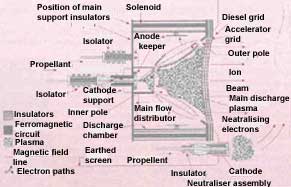Less fuel, more fire
 the speed of a rocket is determined by an old law: every action has an equal and opposite reaction (Newton's third law of motion). Current rocket technology is dependent on the speed of the exhaust gases emitted from its nozzle. If this speed could be increased by accelerating the gases in an electric field, then the amount of fuel a spacecraft would have to carry would be greatly reduced. British scientists are using this idea to develop a new engine for an experimental communications satellite for the European Space Agency (esa). Xenon gas is ionised in a plasma discharge and accelerated by a voltage applied to a grid system to increase the speed of chemical rockets by 10 times.
the speed of a rocket is determined by an old law: every action has an equal and opposite reaction (Newton's third law of motion). Current rocket technology is dependent on the speed of the exhaust gases emitted from its nozzle. If this speed could be increased by accelerating the gases in an electric field, then the amount of fuel a spacecraft would have to carry would be greatly reduced. British scientists are using this idea to develop a new engine for an experimental communications satellite for the European Space Agency (esa). Xenon gas is ionised in a plasma discharge and accelerated by a voltage applied to a grid system to increase the speed of chemical rockets by 10 times.
Increase in exhaust speed is needed for space travel. This is where ion thrusters come in, because exhaust speed is achieved by accelerating gas particles in an electric field which is only limited by the applied voltage. The obstacle is that, for the electric field to work, the particles have to be electrically charged
Related Content
- Bhutan State of Environment Report: The Monthly Overview, November, 2013
- Growing green: the economic benefits of climate action
- Technology roadmap: high-efficiency, low-emissions coal-fired power generation
- JSW May Not Transfer Africa Mine to Energy Co
- Study Finds More of Earth Is Hotter and Says Global Warming Is at Work
- Access to energy for the poor: the clean energy option
